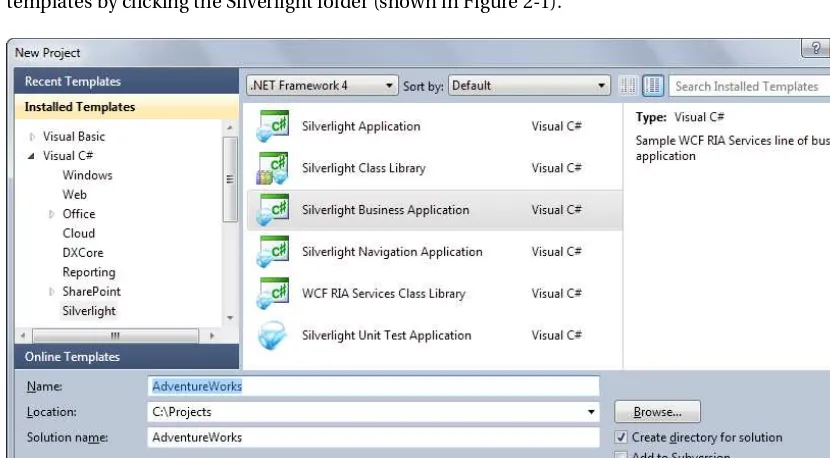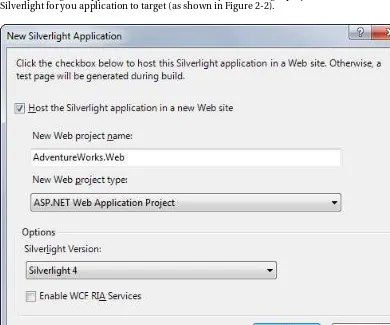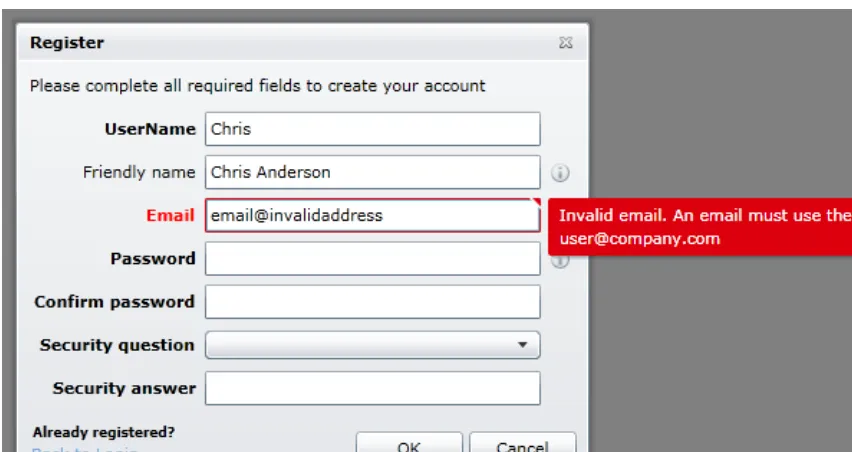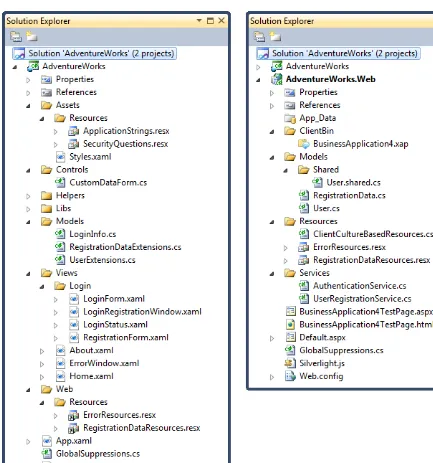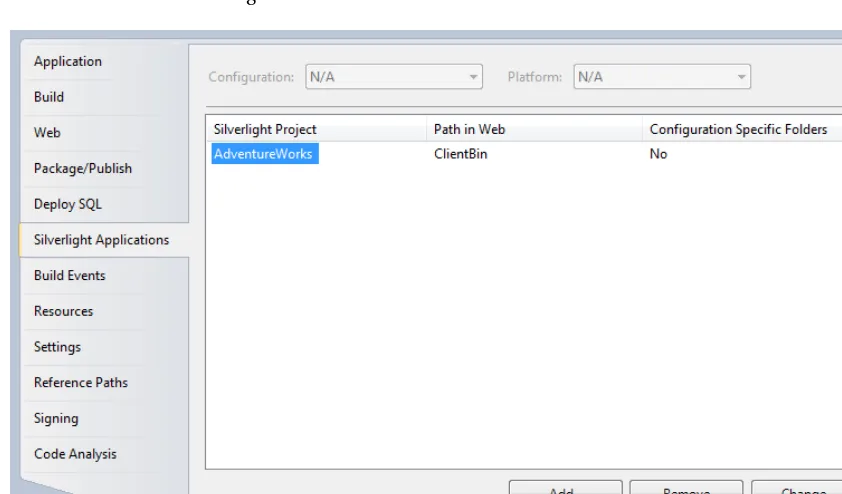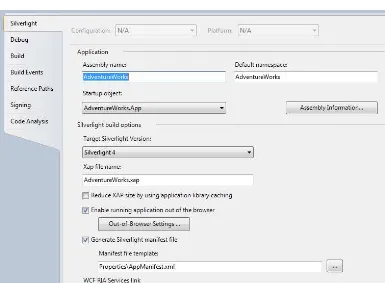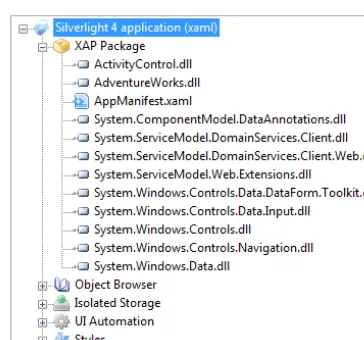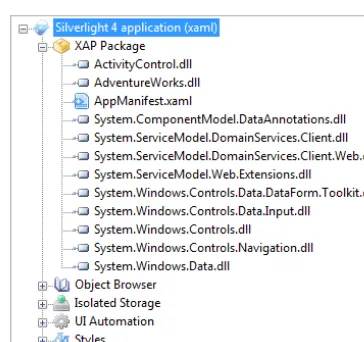Pro
Business Applications
with
Silverlight 4
Chris Anderson
Create rich business applications customized
to your needs quickly and efficiently
Pro Business Applications
with Silverlight 4
Chris Anderson
Pro Business Applications with Silverlight 4 Copyright © 2010 by Chris Anderson
All rights reserved. No part of this work may be reproduced or transmitted in any form or by any means, electronic or mechanical, including photocopying, recording, or by any information storage or retrieval system, without the prior written permission of the copyright owner and the publisher.
ISBN-13 (pbk): 978-1-4302-7207-6
ISBN-13 (electronic): 978-1-4302-7206-9
Printed and bound in the United States of America 9 8 7 6 5 4 3 2 1
Trademarked names may appear in this book. Rather than use a trademark symbol with every
occurrence of a trademarked name, we use the names only in an editorial fashion and to the benefit of the trademark owner, with no intention of infringement of the trademark.
President and Publisher: Paul Manning Lead Editor: Jon Hassell
Technical Reviewer:
Editorial Board: Clay Andres, Steve Anglin, Mark Beckner, Ewan Buckingham, Gary Cornell, Jonathan Gennick, Jonathan Hassell, Michelle Lowman, Matthew Moodie, Duncan Parkes, Jeffrey Pepper, Frank Pohlmann, Douglas Pundick, Ben Renow-Clarke, Dominic Shakeshaft, Matt Wade, Tom Welsh
Coordinating Editor: Tracy Brown
Copy Editors: Julie Hammond, Damon Larson, Heather Lang, Kim Wimpsett. Compositor: Bytheway Publishing Services
Indexer: Toma Mulligan Artist: April Milne
Cover Designer: Anna Ishchenko
Distributed to the book trade worldwide by Springer-Verlag New York, Inc., 233 Spring Street, 6th Floor, New York, NY 10013. Phone 1-800-SPRINGER, fax 201-348-4505, e-mail [email protected], or visit www.springeronline.com.
For information on translations, please e-mail [email protected], or visit www.apress.com.
Apress and friends of ED books may be purchased in bulk for academic, corporate, or promotional use. eBook versions and licenses are also available for most titles. For more information, reference our Special Bulk Sales–eBook Licensing web page at www.apress.com/info/bulksales.
The information in this book is distributed on an “as is” basis, without warranty. Although every precaution has been taken in the preparation of this work, neither the author(s) nor Apress shall have any liability to any person or entity with respect to any loss or damage caused or alleged to be caused directly or indirectly by the information contained in this work.
For my grandmother Connie, a great role model for will power, optimism,
Contents at a Glance
Contents at a Glance ... iv
Contents... v
About the Author... xix
Acknowledgments ... xx
Chapter 1: Introduction...1
Chapter 2: Getting Started with Silverlight...13
Chapter 3: An Introduction to XAML ...35
Chapter 4: The Navigation Framework ...73
Chapter 5: Exposing Data from the Server: Using WCF RIA Services...93
Chapter 6: Implementing Summary Lists ...141
Chapter 7: Building Data Entry Forms ...189
Chapter 8: Securing Your Application...245
Chapter 9: Styling Your Application...269
Chapter 10: Advanced XAML and Data Binding ...287
Chapter 11: Creating Custom Controls ...331
Chapter 12: The Model-View-ViewModel (MVVM) Design Pattern...373
Chapter 13: Printing and Reporting ...403
Chapter 14: Out of Browser Mode, and Interacting with the
Operating System ...427
Chapter 15: Application Deployment ...483
Contents
Contents at a Glance ... iv
Contents... v
About the Author... xix
Acknowledgments ... xx
Chapter 1: Introduction...1
Who This Book Is For ...1
About This Book...2
About the Author...3
Silverlight Overview...4
What Is Silverlight?... 4
A Short History of Silverlight ... 6
What Can Silverlight Bring to Your Business Application? ... 7
When Should You Not Use Silverlight? ... 8
Comparing Silverlight to Other Microsoft Platforms... 9
Comparison with Adobe Flash/Flex ... 11
Business Applications Overview...11
Summary ...12
Chapter 2: Getting Started with Silverlight...13
Required Tools...13
Visual Studio... 13
Silverlight 4 Tools ... 15
WCF RIA Services ... 15
Silverlight Toolkit... 15
SQL Server 2008 Express Edition ... 15
Silverlight Spy (and .NET Reflector)... 16
Creating a Silverlight Application ...16
Silverlight Application... 17
Silverlight Navigation Application... 18
Silverlight Business Application ... 18
Silverlight Class Library... 18
WCF RIA Services Class Library... 19
Silverlight Unit Test Application... 19
Running and Exploring the Default Silverlight Business Application Project...19
Exploring the Initial Silverlight Project Structure...22
Project Links... 24
The Web Application Project Structure... 26
The Silverlight Application Project Structure... 28
Recommended Project Template Modifications ...31
XAP Files...32
Summary ...33
Chapter 3: An Introduction to XAML ...35
Overcoming XAML’s Steep Learning Curve ...35
Why Learn XAML?...36
XAML Syntax, Document Structure, and Features...37
Core XAML Syntax ... 37
Creating an Object Hierarchy... 38
Namespaces ... 39
Attached Properties ... 44
XAML Namespace Properties ... 45
Design-Time Properties... 46
Markup Extensions ... 47
Namescopes ... 49
Controls ...50
Base Control Classes ... 51
Layout Controls... 53
XAML vs. Windows Forms Controls’ Property Names ... 57
Assigning Event Handlers... 58
Creating a Simple User Interface... 60
Resources and Resource Dictionaries ...62
Styles ...64
Templates ...65
Data Binding ...65
Binding to an Object ... 66
Binding to a Collection... 69
Designing User Experiences ...70
The Designer/Developer Workflow ...71
XAML User Interfaces: A Different Perspective...71
Summary ...72
Chapter 4: The Navigation Framework ...73
Getting Started with the Navigation Framework ...73
Components of the Navigation Framework ...75
The Frame Control ... 75
The Page Class ... 76
The NavigationService Object... 76
Navigating Between Views ...77
View URIs... 77
Navigation Methods on the Frame Control ... 78
Navigation Methods on the NavigationService Object... 78
Using a HyperlinkButton Control... 79
Using the Source Property of the Frame Control ... 79
User-Initiated Navigation... 79
Passing Data Between Views ...80
Passing Data Using Query String Parameters ... 80
Reading Query String Parameters ... 81
Passing Complex Data Types Between Views ... 82
Deep Links ...82
URI Mapping to Enable Friendly URIs...83
Integrating with the Browser History...85
Handling Navigation Events ...87
Frame Events... 87
View Events ... 88
Caching Views ...89
Visual Transition Effects ...90
Alternative User Interface Frameworks ...91
Summary ...91
Chapter 5: Exposing Data from the Server: Using WCF RIA Services...93
What Is WCF RIA Services?...94
How the WCF RIA Services Code Generator Works...95
How Do You Use WCF RIA Services? ...96
Linking Your Silverlight and Web Projects... 97
Consuming the Domain Services... 98
Getting Started...98
Creating a Data Access Layer Using the Entity Framework...101
Configuring the Database ... 101
About the Entity Framework ... 101
Creating an Entity Model ... 102
Domain Services...102
Understanding the Domain Service Life Cycle... 103
Creating a Domain Service ... 104
Domain Operations ...107
Query Operations... 107
Insert/Update/Delete Operations ... 109
Invoke Operations... 111
Custom Operations ... 111
Decorating Entities ...112
Metadata Classes ... 113
Controlling Client Entity Generation... 113
Validation... 115
Presentation ... 118
Miscellaneous Data Annotations ... 118
Presentation Model Types ...119
Creating the Presentation Model Class... 120
Populating and Exposing Your Presentation Model Types... 121
Updating Your Presentation Model Types... 122
Sharing Code/Logic Across Tiers...123
Inspecting the Generated Code in the Silverlight Project ...124
Encapsulating Logic in a Separate WCF RIA Services Class Library...125
Handling Data Concurrency Violations...127
Methods of Identifying Concurrency Violations . ... 127
Configuring the Entity Model to Check for Concurrency Violations . ... 128
Testing Your Solution . ... 129
Resolving Conflicts in the Domain Service . ... 130
Transactions ...131
WCF RIA Services Toolkit. ...132
Alternative Communication Technologies ...133
WCF Services. ... 134
WCF Data Services . ... 137
HTTP Requests . ... 138
Sockets. ... 139
Summary ...139
Chapter 6: Implementing Summary Lists ...141
Exposing a Summary Collection from the Server ...142
Collections and Collection Views ...144
ObservableCollection<T> . ... 144
Views . ... 144
Consuming Data from the Server ...146
Understanding the Domain Context. ... 146
XAML-Based Approach. ... 146
Code-Based Approach . ... 148
Choosing the Right Approach . ... 149
Explicitly Specifying a Domain Service Host . ... 150
Using the BusyIndicator Control . ... 150
Displaying the Summary List ...152
Retrieving the Data from the Server. ... 153
Choosing the Right Control ... 164
Manipulating Summary Lists ...165
Querying Data Exposed by a Domain Operation ... 165
Filtering the Summary List ... 168
Sorting the Summary List... 170
Grouping the Summary List ... 172
Paging the Summary List ... 175
Drilling Down on a Record ...178
Opening Details in a New View... 179
Opening Details in a Pop-Up Window ... 180
Displaying Details Using the DataGrid’s Row Details ... 183
Implementing a Master/Details View... 184
Handling Errors ...184
Summary ...187
Chapter 7: Building Data Entry Forms ...189
Creating the Data Entry User Interface ...189
Laying Out the Data Entry Form... 189
Refining the Data Entry Form’s Functionality ... 201
Using the DataGrid for Data Entry... 212
Structuring Objects for Use by Data Entry Forms ...216
Implementing the INotifyPropertyChanged Interface ... 216
Implementing the IEditableObject Interface ... 220
Adding Calculated Properties to Your Classes... 222
Data Validation...223
Displaying Validation Errors... 223
Types of Data Validation ... 226
Defining Validation Rules... 227
Notifying the User Interface of Object-Level Validation Errors ... 234
The Validator Class ... 235
Customizing Validation Attribute Error Messages ... 238
Submitting Changes to the Server...238
Change-Tracking ... 238
Submitting Changes via the DomainDataSource Control ... 239
Submitting Changes via a Domain Context ... 239
Handling Errors... 240
Handling Concurrency Violations... 242
Summary ...243
Chapter 8: Securing Your Application...245
Implementing Server-Side Security Using RIA Services...245
The ASP.NET Membership API... 246
Configuring Your Database for Forms Authentication ... 247
Authentication ... 249
Requiring Authentication ... 250
Role-Based Operation Access Restrictions ... 251
Returning a Subset of Data Based on the User’s ID or Role ... 253
Permitting Update/Delete Operations According to Data... 253
Exposing Custom User Profile Data ... 253
User Registration ... 254
Avoiding SQL Injection Attacks... 255
Sanitizing Errors Sent to the Client... 256
Implementing Client-Side Security ...256
Authenticating and Registering Users ... 256
Accessing and Updating User Information ... 259
Implementing Client-Side Restrictions ... 260
Storing Data Locally... 262
Cross-Domain Access Policies ...263
Implementing Cross-Domain Policies for HTTP-Based Communication... 264
Implementing Cross-Domain Policies for Socket-Based Communication ... 265
Implementing Cross-Scheme Access Policies ... 265
Restricting Access to Your Application ...266
Summary ...268
Chapter 9: Styling Your Application...269
The Designer/Developer Workflow ...269
Defining Style Resources...271
Defining a Style Resource ... 272
Defining Style Resources at Various Locations ... 273
Naming Style Resources ... 275
Inheriting Style Resources... 276
Styling Constraints ... 277
Control Templates...277
Default Control Templates ... 278
Templating a Control ... 278
Control Template Structure ... 279
Theming...282
Creating a Custom Theme ... 282
Silverlight Toolkit Themes ... 283
Silverlight Navigation/Business Application Themed Project Templates ... 283
Icons and Images...283
Animation...284
Pixel Shaders / Effects...284
Miscellaneous Styling Tips ...285
Defining Constants in XAML ... 285
Summary ...286
Chapter 10: Advanced XAML and Data Binding ...287
Advanced XAML ...287
Comments in XAML ... 287
Defining Constants ... 288
Using OR to Combine Enumerated Values in XAML ... 289
Triggers, Actions, and Behaviors... 289
Blendability... 299
Creating Consolidated Namespaces... 301
MoXAML Power Toys ... 303
Advanced Data Binding...303
Assigning the Source of a Binding... 304
Binding to a Resource ... 308
Defining Resources in the Code-Behind (For Binding To)... 311
Binding to Nested Properties... 311
Binding to Indexed Properties ... 312
Binding to Collection Views ... 312
Enhancing Data Binding ... 317
Data Binding in Code ... 323
Getting and Setting Attached Property Values in Code... 324
Additional Tips ... 324
Summary ...329
Chapter 11: Creating Custom Controls ...331
Adding Functionality to an Existing Control ...331
Creating User Controls...332
Creating a Simple User Control ... 332
Exposing Properties... 333
Exposing Events ... 346
Determining If in Design-Time or Runtime Mode ... 347
Constraining the User Control’s Size ... 347
Creating Custom Controls ...347
Creating the Custom Control ... 348
The Control Structure ... 349
Defining the Control’s Default Template... 350
Defining the Control’s Behavior ... 359
Content Controls ...365
Containing a Single Control as Content ... 365
Containing Multiple Controls as Content ... 367
Attached Properties ... 369
Summary ...370
Chapter 12: The Model-View-ViewModel (MVVM) Design Pattern...373
The Purpose of Implementing MVVM...374
Why You Should Implement MVVM...375
MVVM Theory...376
The Layers ... 376
View / View Model Configurations... 379
MVVM in Practice...380
Creating the Layers ... 380
Connecting the Layers... 383
View and ViewModel Interactions ... 385
Layer Interaction Summary ... 392
Hotly Debated Implementation Details ... 393
MVVM and RIA Services...395
Implementing the Model... 395
Implementing the View... 399
Frameworks...401
Summary ...401
Chapter 13: Printing and Reporting ...403
The Importance of Implementing Reporting ...403
Potential Solutions for Implementing Reporting ...404
Generating a PDF... 404
Generating HTML ... 405
Generating Office Documents... 405
Using Silverlight 4 Printing Functionality... 405
Third-Party Report Viewers ... 405
Office Integration Using COM ... 407
Choosing a Reporting Strategy ...407
Printing Functionality in Silverlight...407
Generating and Displaying a PDF Report ...409
Generating a Report on the Server ... 409
Displaying the Report on the Client ... 418
Summary ...426
Chapter 14: Out of Browser Mode, and Interacting with the
Operating System ...427
Out of Browser...427
Configuring OOB Mode ... 428
Installing the Application to Run Out of Browser... 429
Determining Installation Status ... 431
Determining Whether Running Inside or Outside the Browser ... 432
Where/How is the Application’s .xap File Stored and Run?... 432
Interacting with the OOB Window... 433
Debugging Out of Browser ... 436
Uninstalling the Application... 436
Toast Notifications... 437
Caching Data Locally ...439
Caching to Isolated Storage... 439
Caching to a Client-Side Database ... 449
Detecting Network Connection Availability ... 451
File System Open/Save Dialogs ...451
The Open File Dialog... 452
The Save File Dialog ... 456
Drag Drop Target ...459
Clipboard ...460
Full Screen...462
Initiating Full Screen Mode... 462
Detecting the Switch to and from Full Screen Mode... 463
Retaining Full Screen Mode When Unfocused... 463
Keyboard Access ... 464
Elevated Trust...464
Enabling Elevated Trust... 465
File System Access... 466
COM Automation... 471
Custom Chrome ... 478
Other Restrictions Lifted By Elevated Trust ... 480
Restrictions Imposed by Elevated Trust ... 481
Disabling Elevated Trust Applications with a Windows Group Policy... 481
Summary ...482
Chapter 15: Application Deployment ...483
Server Requirements... 484
Using Xcopy ... 485
Publishing... 486
Creating a Web Package ... 487
Creating a Setup Program ... 488
Deploying the Application to the Client...488
The Default Silverlight Installation Process ... 489
Customizing the Silverlight Installation Experience ... 490
Pushing the Silverlight Runtime to Users in the Enterprise... 493
Building a Client Desktop Installer... 494
Improving on the Default Application Loading Screen...495
Creating the Application Pre-loader Files... 496
Designing the Application Pre-loader ... 497
Updating the Application Download Progress ... 499
Configuring the Application Pre-loader in the HTML File... 500
Testing the Application Pre-loader ... 500
Partitioning Your Application ...502
Initial Steps... 502
Assembly Caching ... 502
Downloading Modules on Demand ... 505
Digitally Signing Your Application...506
Summary ...511
About the Author
Chris Anderson has been a professional developer for over 10 years, specializing in building desktop, web, and mobile business applications using Microsoft technologies for industries as wide ranging as accounting, property valuation, mining, the fresh produce industry, logistics, field services, sales, and construction. He holds a Bachelor of Engineering in Computer Systems with a Diploma in Engineering Practice.
Chris is now a co-owner of Peer Placements (a specialist recruitment firm for software developers), in addition to working as a consultant, author, and Australian representative of the SilverlightShow.net website. Currently specializing in Silverlight Chris has spoken on this topic at conferences such as Code Camp Australia, TechEd Australia, Silverlight Code Camp Australia, REMIX Australia, and numerous Sydney Silverlight Designer and Developer Network (SDDN) meetings (for which he is a co-organizer). Chris maintains a blog at http://chrisa.wordpress.com, and can be found on Twitter at
Acknowledgments
I had no idea what I was getting into when taking on this book. Writing a book is a long, arduous task that consumes your entire life, but now that this book is complete I would like to thank those who were instrumental in helping it come to fruition.
I’d like to start by thanking the members of the Apress team with whom I worked closely throughout the writing process. I’m grateful for their guidance and encouragement. I’d like to thank Jonathon Hassell and Anne Collett, and in particular Tracy Brown, who was extremely patient with me even as deadlines were rapidly approaching. My great thanks also go to my technical editor Ilia Iordanov, who, with an eagle eye, spotted many issues I had missed, and made some great suggestions.
I would especially like to thank Greg Harris (www.GregMHarris.com) who gave his time to review every chapter in its draft form, and who provided me with extensive feedback. I really appreciate the amount of time and effort Greg voluntarily spent on this project. His contributions are invaluable.
I would also like to thank Miguel Madero and Pencho Popadiyn, who provided additional valuable feedback on the Model-View-ViewModel Design Pattern chapter, and Sergey Klementiev for providing a solution to a problem I had with RIA Services. My thanks also go to all the Silverlight bloggers who provided solutions to difficult problems. I’ve credited you in the text when you’ve provided information that helped me along my way.
Introduction
Silverlight is a web-based platform from Microsoft that can be used to build rich Internet applications (RIAs). Of the many new possibilities it enables, one receiving a lot of attention is its huge potential as a platform for building business applications. Despite its relative youth (having just reached its third birthday), it has achieved remarkable maturity, with its development progressing at a rapid rate—now at version 4. With just nine months separating versions 2 and 3, and a further nine months separating versions 3 and 4, its tremendous growth in that short time demonstrates the enormous amount of effort and commitment that Microsoft is pouring into Silverlight to bring it to the forefront as one of its core development platforms. Community support for the technology has been overwhelmingly positive, gaining more and more momentum as companies increasingly choose it over more mature platforms. This ensures its future as a viable platform for delivering applications that you can be sure will only grow and become ever more popular.
If you have previously only been exposed to Windows Forms and ASP.NET development, then it will no doubt be a brave new world and one with a steep learning curve, but ultimately the benefits make the initial effort worthwhile. However, with this book to help you through your journey, you should find that a lot of pain will be taken out of this learning curve, guiding you in the right direction while you build your first business application in Silverlight.
Who This Book Is For
This book covers not just Silverlight as a technology, but also the important concepts in designing and developing business applications. From structuring your application to actually implementing features, it covers most of the lifespan of developing a business application in Silverlight.
About This Book
This is not a book simply about Silverlight as a technology, and it isn’t about covering Silverlight from end to end. Silverlight features such as streaming video, Deep Zoom, animations, sounds, and others that are not generally a core requirement in business applications will not be covered. This is a book specifically targeting the needs of designing and developing business applications, and how to do so when using Silverlight as a development platform. That said, you may be well versed in the process of business application design and merely be interested in how to apply your knowledge to developing business applications in Silverlight—this book caters to you too. You may even pick up a few things as you go!
You may have noticed that many books, web articles, and presentations take a rather simplistic view when discussing building business applications in Silverlight, and these techniques rarely hold up to scrutiny in real-world projects. Instead of just giving you all the pieces and leaving you to fit them together yourself, this book is designed to act as your guide when creating your own business
application, leading you through the difficult problems you will encounter and providing one or more solutions for each problem. Business applications involve more than simply retrieving some data and displaying it on the screen—this book will allow you to peer into all the nooks and crevices that represent good business and application design practices.
This book is designed to be read from start to end rather than simply being a reference guide. Concepts will be introduced gradually to save overwhelming you with too much information at one time. This means that when some concepts are introduced, we will take shortcuts in other areas in order to focus your attention on the concept being taught, and move on to more robust implementations in subsequent chapters. Therefore, some of the Silverlight-specific lessons in early chapters are not designed to be put into immediate use, as they won’t necessarily reflect all the recommended
development practices in real-world projects, but are provided merely as a means of easing you into the world of Silverlight development.
Note
For example, the Model-View-ViewModel (MVVM) design pattern commonly used in Silverlight/WPF
business application development is not covered until the later parts of the book. You will probably want to use this
pattern in your applications, but the earlier chapters forgo this pattern in their examples as it introduces a lot of
complexity that will potentially confuse you when attempting to focus on and convey other important concepts.
Despite its position in the later parts of the book, incorporating this design pattern into your project should not be
an afterthought. Therefore, this book should not be considered a step-by-step guide, but an all-encompassing
guide to all the concepts important to building business applications in Silverlight.
By the completion of this book you will have learned most of the techniques for designing robust business applications and how to implement these techniques with a Silverlight-based project. While it would be impossible to cover each and every concept that could be employed when designing and developing business applications, this book will cover those that are the most important for developing a well-structured business application.
Silverlight application to communicate with a server, it would be simply impossible to cover them all and do them justice. For this reason I chose to cover one technology in depth. For most end-to-end business applications in Silverlight (which is the primary focus of this book), RIA Services is your best option for handling communication between the Silverlight client and the server, and therefore this book will focus on using that technology as the framework for this task.
Note
If you decide RIA Services is not suitable for your needs, don’t despair—the functionality covered in this
book is not solely dependent on RIA Services, and there should still be large amounts of information useful to your
project.
Note that you don’t need to use every concept taught in this book in your own applications, as at times some of the concepts may be excessive (depending on the size and type of project you are working on) or inappropriate. These concepts will be noted with the scenarios that they are most suitable for, in order to help you make an informed choice.
About the Author
My name is Chris Anderson and I will be guiding you on your journey building business applications in Silverlight. Throughout my career as a developer I’ve designed and built many business applications across multiple platforms and a number of industries, including construction, finance, sales, logistics, and field services, to name just a few. However, despite all my development experience, I still faced a steep learning curve when I first came face to face with Silverlight. Back then, Silverlight was still in its infancy, but I could see its future potential as a platform for applications of all types—especially in the area of business application development. It had a small runtime, could be easily deployed, had a lot of exciting potential for rich user experiences, and best yet, had the power of the .NET Framework behind it (albeit a subset, but a substantial subset).
While it wasn’t a vision shared by many people at the time, there was quite an interest in the topic when I started writing about it. I published a series of articles on the topic on SilverlightShow
(www.silverlightshow.net) (for Silverlight 2 beta 2, and then Silverlight 2 RTW), but it was still somewhat hard going, with a lot of hurdles to jump and issues to work around. However, it was obviously a market that Microsoft saw potential in too, and with the beta release of Silverlight 3 there was suddenly a big focus on support for developing business applications (making much of my previous work redundant in the process). The vision had suddenly become reality.
Developing business applications in Silverlight has become substantially easier since those days, but you will still face a steep learning curve that will make getting up to speed a little slower than you might like (primarily in order to effectively use XAML to design your user interface). I’ve specifically structured and written this book to help you through that learning curve, guide you in the right direction, and solve the problems you are likely to encounter, so you can be working and productive in minimal time.
Silverlight Overview
Microsoft has a number of different platforms for building applications, with Silverlight being the newest addition to the family. Let’s take a look at what Silverlight is and how it fits into the big picture of
software development platforms.
What Is Silverlight?
It’s important at this stage to establish exactly what Silverlight is and what it isn’t. Silverlight is an RIA platform. RIAs could be considered a cross between desktop applications and web applications. They run within the user’s web browser (with some exceptions), and use a browser plug-in to run the application within a sandboxed environment. RIAs are not a new concept, although not all have been a success for various reasons. Adobe Flash is a notable exception, having achieved huge popularity over the last decade, as well as a market penetration of 99 percent of Internet-enabled personal computers in mature markets and 98 percent in the enterprise (according to Adobe’s own statistics available here: www.adobe.com/products/player_census/flashplayer).
You will find a number of parallels between Silverlight and Adobe Flash. Both run as browser plug-ins, providing a platform for self-contained applications running on the client (as opposed to being dependent on a server controlling the application). Of course, there are numerous differences between the two technologies, but if you take a look at the space in which Silverlight is competing, Adobe Flash (combined with Adobe Flex) is without doubt Silverlight’s biggest competitor.
Market Penetration/Reach
Although Adobe Flash has an almost ubiquitous market penetration, Silverlight is rapidly catching up. Scott Guthrie (corporate vice president, .NET Developer Platform) announced at PDC (in November 2009) that the market penetration was at 45 percent of all Internet-connected devices in the world (note that this is a broader measure than that of Adobe’s), and at the launch of Silverlight 4 in April 2010 he announced that it was now approaching 60 percent. For in-house business applications, the issue of Silverlight’s market penetration is of little concern, as the Silverlight runtime can be incorporated into the organization’s standard operating environment (SOE) and deployed automatically to all the machines throughout the organization. However, for public-facing applications, you should be aware that not all client machines will have the Silverlight runtime installed. Deploying both the Silverlight runtime and your application effectively to users is detailed in Chapter 15.
Note
Another good source of statistics comparing the two platforms is www.riastats.com.
Focus
and supporting controls, and the RIA Services framework, it has also become a viable platform for many business applications.
Compatibility
The Silverlight browser plug-in works with all major browsers and across the two most popular operating systems—Microsoft Windows and Apple Macintosh (Intel x86–based machines only). The Moonlight project (by the team from Novell working on Mono, a cross-platform open source implementation of the .NET Framework) can be used to run Silverlight applications on Linux, but unfortunately its releases lag behind the Microsoft releases.
At the time of writing, there is currently no support for mobile operating systems such as Windows Mobile (which is superseded by the Windows Phone 7 mobile operating system), Apple’s iPhone, Symbian (for Nokia devices), BlackBerry, or Google’s Android, although there are future plans to provide support for some of these devices.
Windows Phone 7
The Windows Phone 7 operating system has a Silverlight-based user interface, meaning that most applications for it will be written in Silverlight. Applications need to be written specifically to run under this operating system, as it won’t run standard Silverlight applications (i.e., you won’t be able to browse to an application in the web browser and run it). Applications written for the phone are essentially Silverlight 3 based; however, this should be enough to enable you to port much of the same code you write for your business applications targeting Silverlight 4 to a Windows Phone 7 version at some point in the future. This will open up many exciting new possibilities for sharing a large portion of your code base (and development knowledge) between both your standard and mobile applications.
The Silverlight Runtime
The Silverlight runtime is a 6MB download (small by today’s standards) including a subset of the .NET Framework and a full implementation of the Common Language Runtime (CLR) engine. This has the huge advantage of enabling you to write code in any .NET language, including (but not limited to) C# and Visual Basic—meaning that you can develop applications in exactly the same language that you are used to working with. Application code is compiled into assemblies, which (along with XAML files and other resources) are combined into a XAP file. This file can then be downloaded to the client and executed within the plug-in. Silverlight applications run within the browser are sandboxed (having extremely limited access to the host machine), meaning that Silverlight applications are inherently safe to be run and cannot cause any damage to the user’s computer (by design).
Out-of-Browser (OOB) Experiences
While Silverlight applications are generally run from within a browser, from version 3 of Silverlight onward they can be run outside of the browser as if they were standard Windows or Macintosh applications. An icon can be placed on the desktop and/or the Start menu to open the application, and the application can automatically update itself when a new version is available on the server. The original implementation of OOB used the same sandboxing model as running the application in the browser, but in version 4 of Silverlight a new feature was added to allow the application to be installed with elevated trust permissions. This enables the application additional access to the host machine, and opens up a new range of possibilities to your Silverlight applications (when the application is being run in OOB mode). With trusted applications in Silverlight 4, you also have access to the Component Object Model (COM), which being a Windows-only feature breaks the truly cross-platform nature of the platform, but enables you to access many Windows features and integrate more tightly with other applications and the operating system.
In the .NET world, Silverlight’s closest relative would be Windows Presentation Framework (WPF). Both use Extensible Application Markup Language (XAML) to define their user interfaces, and Silverlight essentially started as a web-deployed subset of WPF. If you are familiar with WPF, you will be able to write Silverlight applications reasonably easily (and vice versa), despite there being a number of features in each that are not available in the other (although they are becoming more aligned with each release of each).
A Short History of Silverlight
Silverlight has matured rapidly in its short three-year lifespan. Let’s take a look at how it has grown in that time.
Before there was Silverlight, there was WPF. Introduced with version 3 of the .NET Framework, it targeted the rich client market, pioneered the use of XAML to define user interfaces, and demonstrated the new possibilities that XAML could enable. WPF applications could be deployed via a web browser (as an XBAP), but they required the full .NET Framework to be installed, and could only be run under Windows.
Silverlight 1: September 2007
Microsoft then started working on a project called WPF Everywhere (WPF/E), which was essentially designed to be a web-deployed subset of WPF that had its own runtime and ran within a browser plug-in. It used XAML to define the user interface and required you to write code in JavaScript. It had little in the way of controls, and was predominantly focused on media-type applications (video, animations, and vector graphics). This became Silverlight 1.
Silverlight 2: October 2008
Silverlight 3: July 2009
Silverlight 3 began to focus its use on developing business applications. It included richer data binding support, the DataForm control, validation controls, and the ability to run Silverlight applications OOB. In addition, although it was in beta, Microsoft simultaneously released a new framework called RIA Services, which provided a powerful and structured means for Silverlight applications to communicate with servers and pass data between them—making business applications easier to develop in Silverlight.
Silverlight 4: April 2010
Whereas Silverlight 3 immediately made creating business applications viable in Silverlight, Silverlight 4 smoothed many of the rough edges. Silverlight 4 introduced printing capabilities (resolving a big complaint by business application developers of a missing feature), implicit styling (making theming your application a lot easier), webcam and microphone support, elevated trust when running outside the browser, COM access, toast notifications, additional data binding capabilities, and more.
What Can Silverlight Bring to Your Business Application?
There are numerous platforms you could develop your business applications upon, so you may be wondering why you should develop business applications in Silverlight. The biggest benefits are undoubtedly the following:
• The deployment model is easy—applications are delivered over the web via a web
browser.
• There’s no need for the full .NET Framework—just a very small runtime.
• Applications can be written in your favorite .NET language (C#, Visual Basic, etc.). • Applications can be run on multiple platforms (namely both Windows and Mac). • It’s faster to develop and richer than HTML-based applications.
Combined, these benefits have created a platform that many developers hope can solve the various problems that they face every day. However, there are many more benefits that can be gained using Silverlight over other technologies.
If you are used to developing HTML-based applications (e.g., using ASP.NET), then you’ll gain the following benefits:
• You are no doubt used to having your applications render differently between
browsers and operating systems. The big advantage of an RIA like Silverlight is that it renders in exactly the same way in each browser and operating system. This saves a lot of time testing and solving cross-browser issues.
• Silverlight applications are richer than HTML applications and faster to develop. • Since Silverlight is a rich client, users don’t have to deal with constant postbacks
to the server, and the applications feel more responsive to the user.
• With the CLR and a subset of the .NET Framework running on the client, you don’t
• Applications can be run offline.
• Applications can be detached and run like a standard application.
If you are used to developing rich client applications (such as with Windows Forms), then you’ll gain the following benefits:
• Silverlight’s use of XAML to define user interfaces enables you to create unique
and flexible user interfaces that have extensive support for data binding, vector graphics, and animations.
• RIA Services makes designing applications that communicate with a server clean
and easy.
• You will be able to share code with Windows Phone 7 and WPF applications. • Users can be set up with both the Silverlight runtime and your application with
ease in a matter of minutes.
As you can see, Silverlight brings a lot to the table, and this book intends to demonstrate how it can lead to brilliant business applications. However, Silverlight is not always the best choice in some scenarios— let’s take a look at those now.
When Should You Not Use Silverlight?
It’s important to choose the technologies you use wisely and not just choose a technology because it’s “cool” or for the sake of it—you need to justify your choice and ensure that the platform will meet the needs of the business, and that the business is obtaining a reasonable return on investment (ROI). As with any technology, Silverlight is not the perfect platform for all development projects. It has strengths and weaknesses that need to be weighed, evaluated, and considered in relation to the problem domain before you commit yourself (and your business!) to that technology. You need to select the most appropriate platform to suit the requirements of the project.
Comparing Silverlight Applications to HTML-Based Applications
In comparison to HTML-based applications, a big issue is Silverlight’s reach. HTML-based applications can be run almost everywhere. Desktop PCs (including Linux) and Internet-capable mobile devices all display HTML (although a little differently at times), meaning that the reach of these applications is almost 100 percent. For machines that can run Silverlight (Windows, Macintosh, and to an extent Linux), the user is required to install a plug-in, which isn’t always possible on locked-down machines in
corporate settings (without getting the IT department involved).
Comparing Silverlight Applications to Rich Desktop Applications
sandboxed, and although the elevated trust and COM features in Silverlight 4 enable you to get around many of these limitations, you do need to run the applications outside of the browser (with elevated trust) in order for those workarounds to be possible.
These are the primary considerations you will have to take into account before choosing Silverlight as a platform. Determine the current and potential future requirements of your application, identify any features that conflict with Silverlight’s limitations, and then decide whether Silverlight is really the best-suited platform for your needs.
Comparing Silverlight to Other Microsoft Platforms
Let’s compare Silverlight with the other core platforms Microsoft provides and identify the primary pros and cons of each.
WPF
Shared features:
• Both use XAML for defining user interfaces (with Silverlight essentially a subset of
WPF).
• Both can be deployed via a browser as sandboxed applications.
Pros:
• WPF has minimal restrictions, and it requires no sandbox (unless deployed via a
browser as an XBAP without full trust turned on).
• WPF has the power of the full .NET Framework behind it.
Cons:
• WPF requires the full .NET Framework to be installed on the machine. • WPF is limited to running on Windows only.
• WPF does not have the hype and community/Microsoft support that Silverlight
has.
Windows Forms
Shared features:• Both can be downloaded via a browser (although Windows Forms applications
cannot be run within the browser like Silverlight applications) and update themselves automatically when a new version is available (using click-once with Windows Forms applications).
Pros:
• It has the power of the full .NET Framework behind it. • It is very easy to develop (no need to understand XAML).
• It is mature, having been around since the inception of the .NET Framework. • It requires no graphical skills to design user interfaces with the standard style of
Windows applications.
Cons:
• It requires the full .NET Framework to be installed on the machine. • It is limited to running on Windows only.
• It is an aging platform with waning support. • Data binding capabilities aren’t as rich.
• User interfaces aren’t as flexible and don’t have the same styling capabilities.
ASP.NET
Shared features:• Both ASP.NET and Silverlight are available via a web browser (for Silverlight
applications, the Silverlight plug-in must be installed first).
Pros:
• ASP.NET runs on almost all Internet-connected devices. • It does not require a plug-in to be installed.
• It has the power of the full .NET Framework behind it (server side only). • It is mature, having been around since the inception of the .NET Framework.
Cons:
• It requires the full .NET Framework to be installed on a Windows server running
IIS (although the Mono project provides a potential alternative).
• Client-side code must be written in JavaScript, requiring learning a different
language.
• It can render differently between browsers, requiring a lot of testing. • Data binding capabilities aren’t as rich.
• It isn’t as rich or responsive (although Ajax and jQuery can help).
Comparison with Adobe Flash/Flex
With Adobe Flash/Flex being Silverlight’s biggest competitor, it’s worth comparing the two (at a high level).
Similar features:
• Both are rich Internet application platforms deployed via a web browser. • Both can run applications outside of the browser (Silverlight with no additional
requirements, Flash with Adobe Air).
• Both use XML-based markup languages to define their user interfaces.
Pros:
• The Flash runtime is almost ubiquitous, installed on almost all Internet-capable
PCs.
• The core Flash runtime is a smaller download (1.8MB vs. 6MB), although running
outside the browser requires the Adobe Air runtime (which is 15MB).
Cons:
• Code must be written using ActionScript, a JavaScript derivative, which is not as
capable or popular as managed code languages (e.g., there’s no equivalent to LINQ and generics), and is specific to Flash/Flex (i.e., code can’t be reused with other applications).
• It requires an additional download to run applications outside the browser (Adobe
Air), and applications must be packaged separately to run in this runtime (whereas the same Silverlight application will run both within and outside the browser).
Business Applications Overview
Business applications—sometimes also referred to as line-of-business (LOB) applications—are core applications critical to the running of a business. Businesses the world over rely on software in order to function, much of which has been custom developed to capture and support the unique processes and needs of the business—without this software, they would not be able to function effectively, or even at all.
Business applications tend to have the following features in common:
• The ability to access and maintain data in a central data store • Server/client communication
• Data validation rules
• The ability to obtain information from the system (via reports) • Security
Each of these facets of business applications will be investigated in this book, with information on how to implement each in Silverlight to produce a complete end-to-end business application.
Summary
Getting Started with Silverlight
TostartdevelopingwithSilverlight,youneedtosetupyourdevelopmentenvironmentwithanumberof toolsthatenableyoutodevelopforSilverlight,andinstallalltherelatedprogramsandtoolsthatare typicallyrequiredforastandardbusinessapplicationproject.Thischapterwillwalkyouthroughgetting yourdevelopmentenvironmentsetupsoyoucanstartdevelopingforSilverlight.Thenwe’lltakealook attheprojecttemplatesthatareaddedtoyourdevelopmentenvironment,andfinallywe’llexplorethe structureofatypicalSilverlightapplication.
Required Tools
ThebestplacetofindallthetoolsyouneedtogetstartedwithSilverlightistheMicrosoftWebPlatform Installer2.0,whichyoucandownloadfromhere:www.microsoft.com/web/downloads/platform.aspx.You willfindthetoolsthatyourequireforSilverlightdevelopmentintheToolscategoryontheWebPlatform tab.
Alternatively,youcanvisittheGetStartedpageontheofficialSilverlightwebsite,at
http://silverlight.net/GetStarted,whichhaslinkstotherequireddownloads.
Thefollowingsubsectionsgiveabreakdownofthevarioustoolsrequired(orrecommended)for Silverlightdevelopment,andwhateachdoes.
Note
Thefollowingsectionsgiveyouastartingpointforwhatyoushouldhaveinstalledinordertobegin
developingSilverlightapplications;however,thesearenotallthetoolsyou’lleventuallyneed—additionaltoolswill
beintroducedasrequiredthroughoutthebook.
VisualStudio
Theoretically,youdon’tneedanintegrateddevelopmentenvironment(IDE)todevelopSilverlight applications,butthatscenarioisonlyforthemosthardcoreofdevelopers.Anysanedeveloperwilluse anIDE,andVisualStudioisarguablythebestIDEavailable.PotentialIDEsthatsupportSilverlight developmentrangefromfreeupward,andtheirfunctionalityandeaseofuseisgenerallyproportionalto theamounttheycost(i.e.,ifyouhavethelatestprofessionaleditionofVisualStudio,youwillhavethe mostfunctionalityavailabletoyouandbefarmoreproductive).TheProfessionaledition(orhigher)of VisualStudio2010isyourbestoptionbyfarasanIDEforSilverlightdevelopment,asithasno
However,forthesakeofsimplicity,anyinstructionsthroughoutthisbookwillrefertotheactiontobe takenintheprofessionaleditionofVisualStudio2010.
Note
NotethatVisualStudio2008doesnotsupportSilverlight4development—youwillneedtoupgradeto
VisualStudio2010ifyouhaven’tdonesoalready.
ExpressionBlend4andSketchFlow
ExpressionBlendcouldbedescribedasadesignerforXAMLuserinterfacesandanimations,althoughits capabilitieshavebeenextendedfromversion3onwardtoincludetheabilitytoeditcode.Youcould technicallybuildanentireSilverlightapplicationusingExpressionBlendonly,butit’snotdesignedtobe usedassuch,andVisualStudioismuchbettersuitedforthispurpose(ExpressionBlendisdesignedto beusedprimarilytotargettheuserinterfacedesign).
ExpressionBlendistargetedtowarddesigners(i.e.,userinterface,userexperience,andgraphics designers)asitsusers(ratherthandevelopers),withafocusonhelpingsupportandenhancethe developer/designerworkflow.Thisbookisprimarilyfocusedonadeveloperaudience;therefore,we’ll spendmostofourtimeinVisualStudiowhendesigninguserinterfaces.Designinguserinterfacesis mucheasierinVisualStudio2010thanitwasinVisualStudio2008,asVisualStudio2010nowhasa muchbetteruserinterfacedesignerthanwaspreviouslyavailable(whichwasessentiallynodesignerat all).However,itisnotasfeaturerichorpowerfulaswhatyou’llfindinExpressionBlend(particularly whenitcomestocreatinganimations).Ifyou’reseriousaboutcreatingadvanceduserinterfaces, ExpressionBlendwillbeaveryusefultoolinyourarsenal.
SketchFlowisaprototypingtoolthatyoucanuseindesigningyourapplication(mappingoutthe flowofyourscreensandtheirlayouts),fromwhichaSilverlight(orWPF)projectcanautomaticallybe generated.SketchFlowisapartofExpressionBlendandtargetsuserexperiencedesigners.
ExpressionBlendisnotafreetool—itmustbepurchasedasastandaloneproductorasapartof ExpressionStudio.Thereisa60-daytrialavailablefromtheMicrosoftwebsiteifyouwanttotrialthe toolsbeforecommittingyourhard-earnedmoney.SketchFlowisbundledasafeatureofExpression Blend.ExpressionDesign(alsoapartofExpressionStudio)canalsobeausefultooltohave(asavector drawingprogram)aswell,butneithertoolisessentialforSilverlightdevelopment.
Note
BothVisualStudioandExpressionStudioareincludedintheMSDNPremiumandtheExpression
Silverlight4Tools
VisualStudio2010comeswithsupportforSilverlight3outofthebox,butyouwillneedtoinstall Silverlight4ToolsinordertodevelopSilverlight4applications.TheSilverlight4Toolsdownload includestheSilverlight4SDK,theSilverlight4developerruntime,WCFRIAServices,andsupportfor Silverlight4inVisualStudio.Oncethesetoolsareinstalled,youwillfindnewprojecttemplatesavailable inVisualStudioforcreatingSilverlightapplications.
WCFRIAServices
WCFRIAServicesprovidesaprescriptivepatternandframeworkforcreatingend-to-endSilverlight applications.TheWCFRIAServicescodegenerator“projects”yourbusinessobjectmodelontheserver ontoyourSilverlightapplicationalongwithsharedbusinesslogic,anditprovidestheinfrastructurethat enablesmethodsontheservertobecalledbyyourSilverlightapplication.We’lltakeathoroughlookat WCFRIAServicesinChapter5.ThisisnowincludedasapartoftheSilverlight4Toolsinstaller,butthere isanassociatedtoolkitthatyoucaninstallwithadditionalfeatures(mostofwhicharestillunder development)ifyouwish.
SilverlightToolkit
TheSilverlightToolkitisafreeandopensourceprojecthostedonCodePlex,developedandmaintained byMicrosoft.Thisisanongoingprojectwithregularreleasesthataddsgreatlytotheavailablecontrols thatyoucanuseinyourSilverlightproject.TheSilverlight4SDKonlycontainsbasicuserinterface controls(TextBox,Button,Canvas,Grid,etc.),sotheSilverlightToolkitprovidesaraftofmoreadvanced controls,suchasTreeView,Calendar,andCharting,amongmanyothers.
BlacklightisasimilaropensourceprojecthostedonCodePlex,butunliketheSilverlightToolkititis acommunity-runprojectanddoesnotattempttooverlapwiththecontrolsavailableintheSilverlight Toolkit.It’snotlistedontheSilverlight.netGetStartedpage,butyoucangetitfromhere:
www.codeplex.com/blacklight.
SQLServer2008ExpressEdition
Businessapplications(asdescribedinChapter1)aredata-centricapplications—hencethey(almost always)interactwithsomesortofdatabase.Youhaveunlimitedoptionsofdatabasestochoosefrom— thedatabaseyouchoosehasnobearingonyourSilverlightapplication,asSilverlightapplicationscan’t readorwritetoaremotedatabasedirectly—youneedtoprovideasetofservicestoexposethedatafrom theservertoclientapplications.Aslongasyoucancommunicatewiththedatabaseinastandard.NET application,youcanprovideawaytoallowyourSilverlightapplicationtocommunicatewithit.Forthe purposesofthisbook,we’llbeusingSQLServer2008ExpressEditionasourdatabaseofchoice,sinceit’s freeandreasonablyfullfeatured.InmostbusinesssettingsyouwouldprobablywanttousethefullSQL Server2008product,withwhichthecodeprovidedwillworkwithoutanychanges.Earlierversionsof SQLServerwouldbeacceptabletoo.YoucandownloadSQLServer2008ExpressEditionfrom
SilverlightSpy(and.NETReflector)
Thisisnotamandatorytooltoobtain,butit’scertainlyrecommended,asitisextremelyhandywhen debuggingyourSilverlightapplication.SilverlightSpy,createdbyKoenZwikstraofFirstFloorSoftware, allowsyoutoinspecttheinternalsofaSilverlightapplication(includingitsfilestructure,XAMLvisual tree,andstyles),monitoritsmemoryandprocessorusage,andmonitoritsnetworkconnector(among manyotherfeatures).Italsointegrateswith.NETReflector(afreetoolfromRedGateSoftware)to decompiletheassemblieswithintheXAPfileandviewtheircode.Fromadebuggingperspectiveit’san invaluabletool.EarlyversionsofSilverlightSpywerefree,butwithitsversion3releaseitbecamea commercialproductwithapriceattached.YoucandownloadSilverlightSpyfrom
http://silverlightspy.com/silverlightspyand.NETReflectorfrom www.red-gate.com/products/reflector.
Creating a Silverlight Application
Onceyouhaveyourdevelopmentenvironmentconfigured,youcanbegincreatingyourfirstSilverlight project.OpentheNewProjectwindowinVisualStudioandtakealookatthenewSilverlightproject templatesbyclickingtheSilverlightfolder(showninFigure2-1).
Figure 2-1. The New Project window
SilverlightApplication
ThisisabasicprojecttemplateforSilverlightprojects,whichwillsimplyincludeasinglepagetostart with.BackinSilverlight2,thiswastheonlyprojecttemplateavailabletocreateaSilverlightapplication, anditdidn’tprovidemuchtogetstartedwith(itwassomewhatablankslate).Thismightbeusefulfor creatingwidgets,games,banners,advertisements,andvideoplayers,forexample—wheninitialproject infrastructureisn’tparticularlyrequired.Forbusinessapplications,ontheotherhand,youwillfindthe SilverlightNavigationApplicationorSilverlightBusinessApplicationprojecttemplatesamuchbetter startingpoint.
Whenyoucreateaprojectusingthistemplate,itwilldisplayawindowallowingyoutocreatea correspondingwebapplicationorwebsitetohostyourSilverlightproject,andselectaversionof Silverlightforyouapplicationtotarget(asshowninFigure2-2).
Figure 2-2. The Silverlight project wizard
WheneveryoucreateaSilverlightproject,youwillwanttohostyourSilverlightapplicationinaweb application/site,andthewebprojectwillbesetasthedefaultprojectinyoursolution.
SilverlightNavigationApplication
Silverlight3introducedanavigationframeworkthatessentiallyprovidesanapplicationframeworkfor Silverlightapplications.Thisprojecttemplateimplementsthenavigationframeworkandprovidesa goodstartingpointforusingit.We’lltakealookatthefeaturesofthenavigationframeworkinChapter 4;however,thisprojecttemplateisidealwhenyouarecreatinganapplication(asopposedtoawidget).
SilverlightBusinessApplication
TheSilverlightBusinessApplicationtemplateissimilartotheSilverlightNavigationApplication
template,butwithanumberofadditionalfeatures.Itautomaticallyassumesyouwantawebapplication project,andlinkstheSilverlightprojectandthewebapplicationprojectwithWCFRIAServices.It includeslogin/registrationscreensandsomebuilt-inauthenticationfunctionality.Inaddition,all stringsarestoredinresourcefilessothattheapplicationcanbeeasilylocalizedandsupportdifferent languages.Thiswillbethetemplatewewillbebasingourapplicationupon.
Note
Ifyoudon’tseetheSilverlightBusinessApplicationprojecttemplateintheNewProjectdialog,ensurethat
youhaveselectedversion4ofthe.NETFrameworkintheframeworkselectiondrop-down.
SilverlightClassLibrary
ASilverlightClassLibraryprojectisessentiallythesameasastandardclasslibraryproject,butismarked foruseinSilverlightprojects(sinceSilverlighttargetsitsownversionofthe.NETFramework).You wouldusethisprojecttemplateifyouwerecreatingacustomcontrollibrary,reusablecodelibrary,or businesslogiclibrary,forexample.Becauselibrariescannotberunontheirown,youwon’tbeasked whethertocreateawebprojecttohostit.
